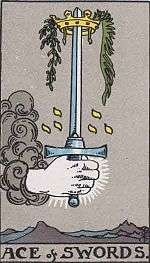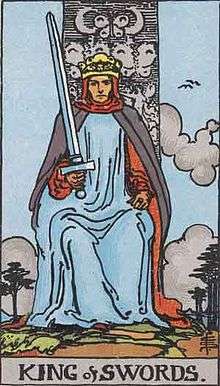Suit of swords

The Suit of Swords is used in Latin suited playing cards, such Spanish, Italian and tarot decks. It corresponds to the Suit of Spades in standard decks.
In tarot, it is part of what is called the "Minor Arcana". Like the other tarot suits, it contains fourteen cards: ace (one), two through ten, page, knight, queen and king.
The suit represents the Second Estate (The Nobles).
Tarot cards are used throughout much of Europe to play Tarot card games.[1] In English-speaking countries, where the games are largely unknown, Tarot cards came to be utilized primarily for divinatory purposes.[1][2]
Divinatory and occult meanings
In tarot, swords correspond to the element of Air, and as such signifies freedom but also quick change. The Swords suit also traditionally represented the military, which implies strength, power and authority, but also responsibility, violence and suffering.
| Image | Name | Attribute | Meaning |
|---|---|---|---|
 |
Ace of Swords | The Reaver | Indicates decisive ability. Cutting through confusion. Taking a radical decision or standpoint. The ability to see through deception, and expose it. |
 |
Two of Swords | The Choice | The two of swords indicates doubt over decisions. A sense of powerlessness and apathy giving way to fear. If the other cards in the spread are favourable, then the Two of Swords can indicate lack of bias and even mindedness. |
 |
Three of Swords | The Wound | This card represents the aspect of the mind which is overly critical, especially of itself. The perverse impulse to dissect a problem beyond the point of usefulness. The three swords are often depicted piercing a bleeding heart. The swords symbolize the intellect, and the heart, the emotions which always suffer under this treatment. |
 |
Four of Swords | The Effigy | The four of swords symbolizes avoidance. Setting problems to the side, (the swords on the wall), while one prays for deliverance. This card can also represent surrender, or in some cases, pacifism. |
 |
Five of Swords | The Traitor | This card symbolizes victory by betrayal. The emptiness which descends after a harsh struggle. The alienation of others through belligerence. |
 |
Six of Swords | The Boatman | A dangerous journey. Readers do not always agree on the alignment of this card. It can indicate a doomed endeavor, or conversely, moving out of troubled waters. It also indicates responsibility for others. |
 |
Seven of Swords | The Thief | This card represents covert activities. The attempt to get away with too much, and being compromised as a result. If the reading is favourable, the card may represent making sacrifices to move ahead. Simplifying. It can also mean manipulative or dishonest behavior at play.[3] |
 |
Eight of Swords | The Prisoner | Feeling trapped and oppressed by others, and powerless to change. Often the condition is self-imposed, but the cause is attributed to external influences. This card can also indicate the stubborn adherence to an ideal. |
 |
Nine of Swords | The Nightmare | Tarot readers do not generally like to categorize cards as bad or good but the Nine of Swords is probably the most dreaded card in the deck. However, it can indicate the process of letting go or grief and, in combination with healing cards like the Queen of Wands, it can be highly beneficial. |
 |
Ten of Swords | The Corpse | The nightmare in The Nine of Swords comes to an end in The Ten. There may be exhaustion, and the result may not be ideal but the ordeal is over and the truth has been outed. The Ten of Swords can also indicate the end of a repetitious cycle. Divorce. |
 |
Page of Swords | The Spy | The ability to observe others keenly, while concealing one's own nature. The talent for keeping secrets. Keeping one's head in the face of danger. The ability to endure suspense. |
 |
Knight of Swords | The Berserker | Wrath. Impatience. Fanaticism. Blind addiction to action as opposed to thought. Also may indicate initiative and courage. |
 |
Queen of Swords | The Widow | This card symbolizes independence, at its best. Power, intelligence, tactical thinking. The ability to streamline a problem, and find the solution without fuss. At worst, The Queen of Swords can represent isolation, depression and cruelty. |
 |
King of Swords | The Warlord | Discipline with passion. Power and insight. Can symbolize tyranny. |
Alternate Decks
| Wikimedia Commons has media related to Swords (playing cards). |
- In French-language decks, the suit is called Epees ("Swords"). The picture cards are Valet (Page), Chevalier (Horseman or Knight), Reine (Queen), and Roi (King). It was later replaced by the suit of Spades.
- In German-language decks the suit is represented by Blätter ("Leaves"). It is probably based on the pun that the words for "sword blade" and "leaf" are the same in German.
- In Swiss decks the suit is represented by Schilten ("Shields"). It is probably derived from the southern German Hofämterspiel ("Householder's Deck") (c.1450s), which used the shields of Imperial Germany, France, Bohemia, and Hungary as suits.
References
- 1 2 Dummett, Michael (1980). The Game of Tarot. Gerald Duckworth and Company Ltd. ISBN 0-7156-1014-7.
- ↑ Huson, Paul, (2004) Mystical Origins of the Tarot: From Ancient Roots to Modern Usage, Vermont: Destiny Books, ISBN 0-89281-190-0 Mystical Origins of the Tarot Archived 2007-09-27 at the Wayback Machine.
- ↑ "Seven of Swords Tarot Card Meanings". Simply Tarot. Retrieved 2015-05-22.